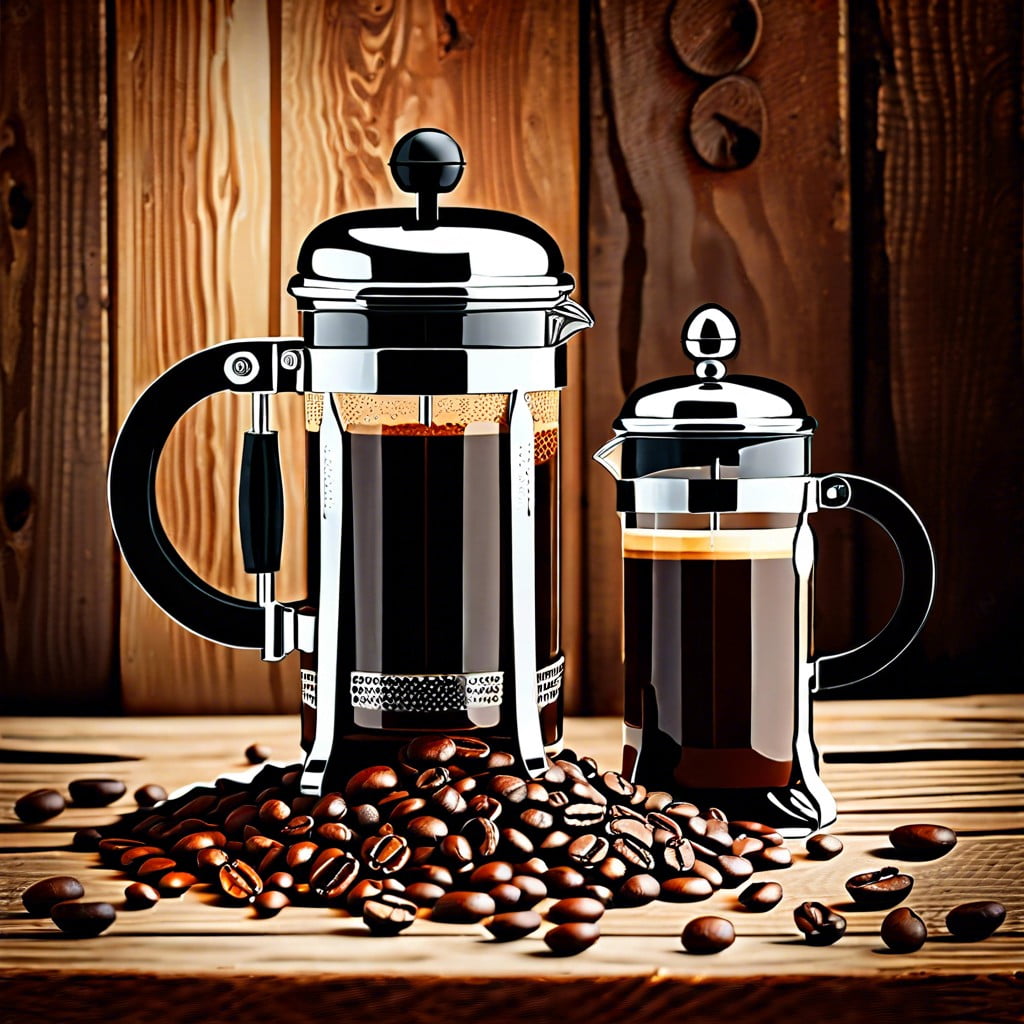Discover how to craft the perfect French press coffee with step-by-step guidance for a full-flavored brew.
Why Is It Called A French Press?

You might be sipping on some robust brew and wondering about the name “French Press.” Let’s dig into a bit of history. Back in 1929, two French inventors patented a rudimentary version of the press pot. Even though it was an Italian designer who later refined and manufactured it, the French connection stuck. The term “French Press” pays homage to those inventors who gave us the early blueprint for our beloved coffee maker.
Curiously, it’s not known as a French Press everywhere. In France, they call it a “cafetière à piston,” and in Italy, where its modern design was perfected, they refer to it as a “caffettiera a stantuffo.” The name might change across borders, but the undeniably rich brewing method remains the same, capturing hearts one plunger at a time.
Best Type Of Grind For French Press
Choosing the right grind for your French press is like selecting the perfect pair of shoes for a marathon—they need to fit just right. Opt for a coarse grind, similar in texture to sea salt. This size allows for optimum extraction without slipping through the press filter and causing a gritty cup.
A finer grind can lead to over-extraction where the coffee becomes bitter. It could also make pressing the plunger tougher—it should feel smooth, not like a gym workout. The coarse grounds ensure a clean, full-bodied brew that’s a delight for the palate.
Remember, a consistent grind is key. Inconsistent sizes can lead to uneven extraction, resulting in a less desirable taste. If in doubt, a burr grinder offers a more uniform grind than a blade grinder. Fine-tuning the grind to hit that sweet spot can elevate your French press coffee from good to exceptional.
How To Make French Press Coffee
Start with boiling water, then let it sit for a minute to reach the optimal temperature, around 195°F to 205°F. Coarse coffee grounds await their hot bath, so measure them out—about one heaping tablespoon per 4 ounces of water is a good rule of thumb.
Pour the hot water over the grounds, saturating all of them. Set a timer for four minutes. This is steeping, not just mixing; it’s the slow dance of flavors, a waltz where water and coffee beans learn each other’s steps.
Once the timer dings, slowly press the plunger down. Apply steady pressure to avoid a rebellion of grounds in your cup. The plunge separates the spent grounds from the bold brew, like a velvet rope between the audience and the stage.
Finally, serve it immediately, because coffee this good doesn’t deserve to wait. The flavor, oh the flavor! It’s full-bodied, rich, and whispers tales of hidden chocolate and nutty undertones with every sip.
Coffee to Water Ratio for French Press
Dialing in the perfect balance between coffee and water can mean the difference between an average cup of java and a transcendent experience. A widely accepted ratio is 1:15, where for every 1 gram of coffee, you add 15 grams of water. This translates to about 2 tablespoons of coffee for every 8 ounces of water if you prefer using standard kitchen measurements.
However, taste buds aren’t uniform across the board, right? Go ahead and tweak that ratio to find your sweet spot. Maybe you’re a bold adventurer of the brew, longing for more intensity. Stepping up to a 1:12 ratio could be your ticket to paradise. Or perhaps gentler sips call your name, and a 1:17 ratio makes your palate sing.
Water temperature is also key; aim for hot but not scalding, typically between 195°F to 205°F. Too hot, and you might escort your coffee’s subtle flavors to a bitter end. Too cool, and your brew might lack the strength to kickstart your day.
Remember this: the French press is not a set-it-and-forget-it affair. Once you pour the water, give the grounds a quick stir to break up any clumps. Ensure the grounds and water mingle well, like guests at a cozy dinner party.
In a nutshell, practice makes the perfect cup. Experiment with ratios and water temperatures. Take notes of what works and what doesn’t. With time, you’ll brew cups of French press coffee that hit the spot, every single time.
Cleaning a French Press
Dismantling your press pot post-brew might feel like performing a magic trick, but there’s nothing up your sleeve here—just coffee grounds begging for a proper send-off. Start by giving the spent grounds a new lease on life; your garden will thank you for the compost.
Now for the main event: take apart the plunger assembly to show each individual part some love. A soft brush or sponge does wonders to sweep away oily residue without scratching the delicate surfaces. Next, kiss goodbye to any lurking coffee oils and fingerprints with a soapy, warm water bath. Rinsing each part thoroughly ensures no soapy ensemble makes an encore during your next brewing act.
Once the pieces are dry, reassemble with the same ease as a seasoned juggler putting down his pins. Your French press is now pristine, ready to perform its next morning routine—no traps, just a clean platform for your coffee’s flavor to leap from.